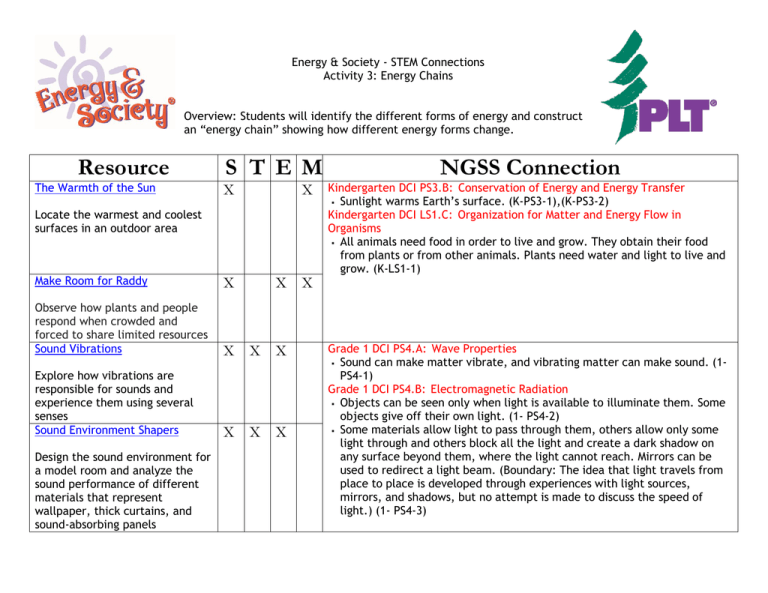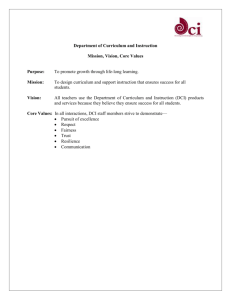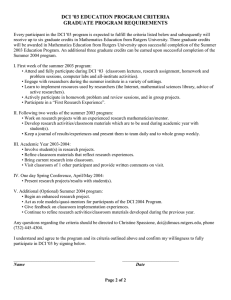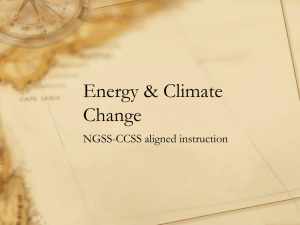Activity 3: Energy Chains
advertisement

Energy & Society - STEM Connections Activity 3: Energy Chains Overview: Students will identify the different forms of energy and construct an “energy chain” showing how different energy forms change. Resource The Warmth of the Sun S T E M X X Make Room for Raddy X X X Observe how plants and people respond when crowded and forced to share limited resources Sound Vibrations X X X Explore how vibrations are responsible for sounds and experience them using several senses Sound Environment Shapers X X X Locate the warmest and coolest surfaces in an outdoor area Design the sound environment for a model room and analyze the sound performance of different materials that represent wallpaper, thick curtains, and sound-absorbing panels NGSS Connection Kindergarten DCI PS3.B: Conservation of Energy and Energy Transfer Sunlight warms Earth’s surface. (K-PS3-1),(K-PS3-2) Kindergarten DCI LS1.C: Organization for Matter and Energy Flow in Organisms All animals need food in order to live and grow. They obtain their food from plants or from other animals. Plants need water and light to live and grow. (K-LS1-1) Grade 1 DCI PS4.A: Wave Properties Sound can make matter vibrate, and vibrating matter can make sound. (1PS4-1) Grade 1 DCI PS4.B: Electromagnetic Radiation Objects can be seen only when light is available to illuminate them. Some objects give off their own light. (1- PS4-2) Some materials allow light to pass through them, others allow only some light through and others block all the light and create a dark shadow on any surface beyond them, where the light cannot reach. Mirrors can be used to redirect a light beam. (Boundary: The idea that light travels from place to place is developed through experiences with light sources, mirrors, and shadows, but no attempt is made to discuss the speed of light.) (1- PS4-3) Resource Light Plants and Dark Plants, Wet Plants and Dry Ones Identify shade-adapted plants after exposing different kinds of seedlings to different conditions of light levels Wind is Energy Apply ideas from NEED’s wind activity packet to create a wind powered toy Levitating Magnets: Floating Isn't Just for Magicians S T E M X X X X Learn how energy can be stored in stationary objects by building a tabletop vehicle that stores energy in the elasticity of a rubber band Grade 2 DCI LS2.A: Interdependent Relationships in Ecosystems Plants depend on water and light to grow. (2-LS2-1) Grade 2 DCI ESS2.A: Earth Materials and Systems Wind and water can change the shape of the land. (2- ESS2-1) X X X X X X X Design experiments to uncover the magic of magnets Potential and Kinetic Energy: Spool Racer NGSS Connection X X X X Grade 3 DCI PS2.B: Types of Interactions Electric and magnetic forces between a pair of objects do not require that the objects be in contact. The sizes of the forces in each situation depend on the properties of the objects and their distances apart and, for forces between two magnets, on their orientation relative to each other. (3-PS23),(3-PS2-4) Performance Expectation 3-PS2-4: Define a simple design problem that can be solved by applying scientific ideas about magnets. [Clarification Statement: Examples of problems could include constructing a latch to keep a door shut and creating a device to keep two moving objects from touching each other.] Grade 4 DCI PS3.A: Definitions of Energy Energy can be moved from place to place by moving objects or through sound, light, or electric currents. (4-PS3-2), (4-PS3-3) Grade 4 DCI PS3.B: Conservation of Energy and Energy Transfer Energy transferred from place to place by electric currents can then be used locally to produce motion, sound, heat, or light. The currents may have been produced to begin with by transforming the energy of motion into electrical energy. (4-PS3-2), (4- PS3-4) Resource S T E M Elastic Energy X X X X Create a simple toy that uses stored elastic energy in order to move Solar Energy Activity Ideas X X X Investigate the sun’s power using a radiometer, solar UFO, and solar oven, while also discussing protection methods from harmful ultraviolet radiation The Sun and its Energy Explore 14, Kindergarten-Grade 4 Activities from the US Department of Energy X X X X NGSS Connection Grade 4 DCI PS3.C: Relationship Between Energy and Forces When objects collide, the contact forces transfer energy so as to change the objects’ motions. (4-PS3-3) Grade 4 DCI PS3.D: Energy in Chemical Processes and Everyday Life The expression “produce energy” typically refers to the conversion of stored energy into a desired form for practical use. (4-PS3-4) Energy is present whenever there are moving objects, sound, light, or heat. When objects collide, energy can be transferred from one object to another, thereby changing their motion. In such collisions, some energy is typically also transferred to the surrounding air; as a result, the air gets heated and sound is produced. (4-PS3-2), (4-PS3-3) Grade 4 DCI ESS3.A: Natural Resources Energy and fuels that humans use are derived from natural sources, and their use affects the environment in multiple ways. Some resources are renewable over time, and others are not. (4-ESS3-1) Performance Expectation 4-PS3-4. Apply scientific ideas to design, test, and refine a device that converts energy from one form to another [Clarification Statement: Examples of devices could include electric circuits that convert electrical energy into motion energy of a vehicle, light, or sound; and, a passive solar heater that converts light into heat. Examples of constraints could include the materials, cost, or time to design the device.] [Assessment Boundary: Devices should be limited to those that convert motion energy to electric energy or use stored energy to cause motion or produce light or sound.] Performance Expectation 4-ESS3-1. Obtain and combine information to describe that energy and fuels are derived from natural resources and their uses affect the environment. [Clarification Statement: Examples of renewable energy resources could include wind energy, water behind dams, and sunlight; non-renewable energy resources are fossil fuels and fissile materials. Examples of environmental effects could include loss of habitat due to dams, loss of habitat due to surface mining, and air pollution from burning of fossil fuels.] Resource Biodomes Engineering Design Project S T E M X X X X Explore environments, ecosystems, energy flow, and organism interactions by creating and monitoring a model “biodome” Cool It! X X X X Learn about evaporative cooling and how it is used in ancient and modern technology by making a refrigerator that works without electricity Reducing Energy Loss X X X X Build two different solar cookers to compare efficiency NGSS Connection Grade 5 DCI LS2.A: Interdependent Relationships in Ecosystems The food of almost any kind of animal can be traced back to plants. Organisms are related in food webs in which some animals eat plants for food and other animals eat the animals that eat plants. Some organisms, such as fungi and bacteria, break down dead organisms (both plants or plants parts and animals) and therefore operate as “decomposers.” Decomposition eventually restores (recycles) some materials back to the soil. Organisms can survive only in environments in which their particular needs are met. A healthy ecosystem is one in which multiple species of different types are each able to meet their needs in a relatively stable web of life. Newly introduced species can damage the balance of an ecosystem. (5-LS2-1) Middle School DCI PS3.B: Conservation of Energy and Energy Transfer The amount of energy transfer needed to change the temperature of a matter sample by a given amount depends on the nature of the matter, the size of the sample, and the environment. (MS-PS3-4) Energy is spontaneously transferred out of hotter regions or objects and into colder ones. (MS-PS3-3) Middle School DCI LS2.B: Cycle of Matter and Energy Transfer in Ecosystems Food webs are models that demonstrate how matter and energy is transferred between producers, consumers, and decomposers as the three groups interact within an ecosystem. Transfers of matter into and out of the physical environment occur at every level. Decomposers recycle nutrients from dead plant or animal matter back to the soil in terrestrial environments or to the water in aquatic environments. The atoms that make up the organisms in an ecosystem are cycled repeatedly between the living and nonliving parts of the ecosystem. (MS-LS2-3) Middle School DCI ESS2.C: The Roles of Water in Earth’s Surface Processes Water continually cycles among land, ocean, and atmosphere via transpiration, evaporation, condensation and crystallization, and precipitation, as well as downhill flows on land. (MS-ESS2-4) The complex patterns of the changes and the movement of water in the atmosphere, determined by winds, landforms, and ocean temperatures Resource S T E M NGSS Connection and currents, are major determinants of local weather patterns. (MSESS2-5) Global movements of water and its changes in form are propelled by sunlight and gravity. (MS-ESS2-4) Performance Expectation MS-PS3-3. Apply scientific principles to design, construct, and test a device that either minimizes or maximizes thermal energy transfer. [Clarification Statement: Examples of devices could include an insulated box, a solar cooker, and a Styrofoam cup.] [Assessment Boundary: Assessment does not include calculating the total amount of thermal energy transferred.] Performance Expectation MS-ESS2-6. Develop and use a model to describe how unequal heating and rotation of the Earth cause patterns of atmospheric and oceanic circulation that determine regional climates. [Clarification Statement: Emphasis is on how patterns vary by latitude, altitude, and geographic land distribution. Emphasis of atmospheric circulation is on the sunlight-driven latitudinal banding, the Coriolis effect, and resulting prevailing winds; emphasis of ocean circulation is on the transfer of heat by the global ocean convection cycle, which is constrained by the Coriolis effect and the outlines of continents. Examples of models can be diagrams, maps and globes, or digital representations.] [Assessment Boundary: Assessment does not include the dynamics of the Coriolis effect.]


